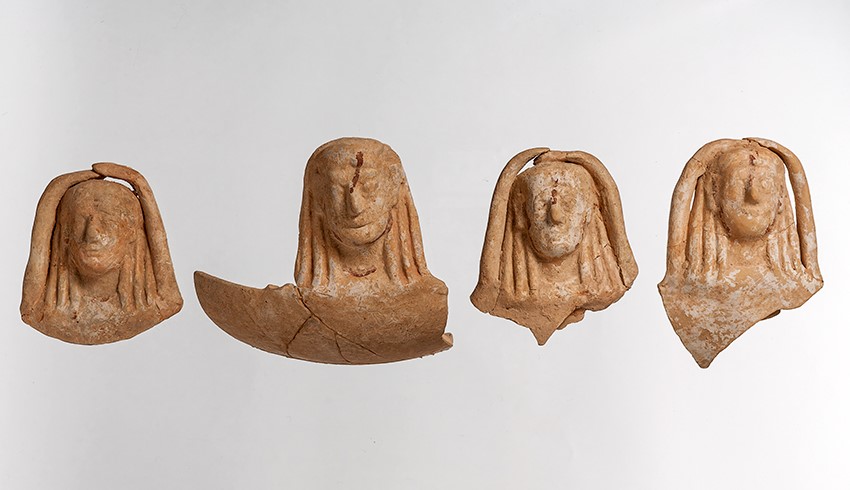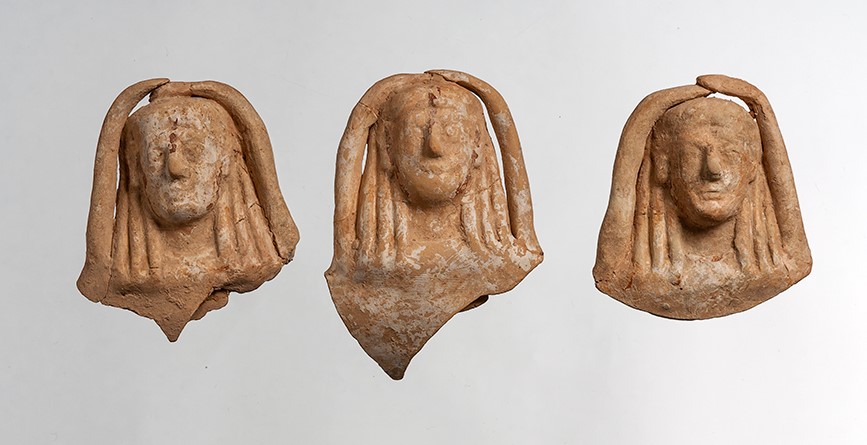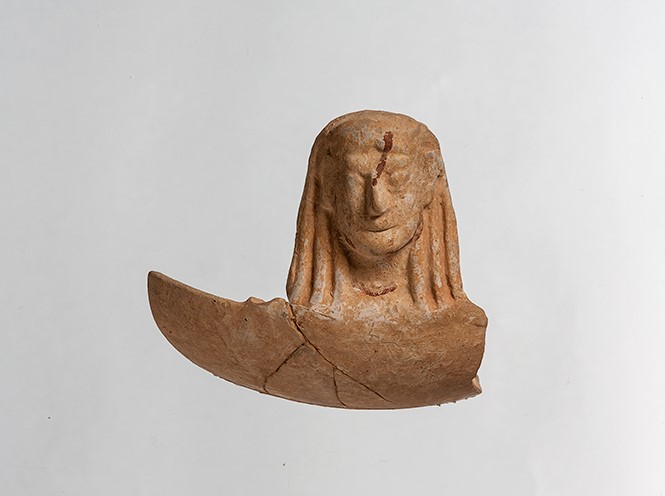Acquisition number: 1981.02
Four sets of fragments of a bowl with protomai of mourning figures about the lip. Pale buff, rather soft, very well levigated clay with some small white and dark inclusions.
The bowl is thin-walled, its thickness a little over 3mm. It was fairly shallow (but was perhaps standed). The four faces are mould-made. The hair is waved at the front and comes down in three long tresses running behind the ears to shoulder-length. The ears are large, the eyes large with prominent upper and lower lids. The mouths are small, closed, but the lips distinguished. About the heads are arms done from thin rolls of clay, overlapping at the top. They are missing from the largest fragment.
There are no traces of paint on the inside. White was applied over the front of the protomai and a dribble runs down the outer wall of the largest fragment. The faces have lines of dark red paint, typically at each side of the face by the ears and running down to the chin, and on the brow above the nose. In three of the four cases there is also a line of red across the neck.
Title: Fragments of a Funerary Bowl with Mourning Figures - 1981.02
Acquisition number: 1981.02
Author or editor: J.R. Green
Culture or period: Protoattic.
Date: Perhaps first quarter of the 6th century BC
Material: Clay
Object type: Sculpture and figurines
Dimensions: 61mm (w) × 60mm (h)
Origin region or location: Greece
Origin city: Attika
Display case or on loan: 3
Keywords: Greek, Protoattic, Attic, Fragment
Münzen und Medaillen (Basle), Auktion 51 (1975) no. 100 (ill.); Münzen und Medaillen (Basle), Terrakotten, Antike Gemmen. Sonderliste S (Oct. 1980) no. 2 (ill.); D. Kurtz, in: H.A.G. Brijder (ed.), Ancient Greek and Related Pottery. Proceedings of the International Vase Symposion in Amsterdam 12-15 April 1984 (Amsterdam 1984) 318 n.53; K.A. Sheedy, “Of Moulds and Mourners”, Bulletin of the Institute of Classical Studies 32, 1985, 118-124, pll. 5-6.
1981.02
Fragments of a Funerary Bowl with Mourning Figures
Purchased. Ht of each protome ca 5.5 - 6cm; width 6.1cm; max. preserved ht ca 7.3cm; est. diam. bowl ca 17/18cm.
Four sets of fragments of a bowl with protomai of mourning figures about the lip. Pale buff, rather soft, very well levigated clay with some small white and dark inclusions.
The bowl is thin-walled, its thickness a little over 3mm. It was fairly shallow (but was perhaps standed). The four faces are mould-made. The hair is waved at the front and comes down in three long tresses running behind the ears to shoulder-length. The ears are large, the eyes large with prominent upper and lower lids. The mouths are small, closed, but the lips distinguished. About the heads are arms done from thin rolls of clay, overlapping at the top. They are missing from the largest fragment.
There are no traces of paint on the inside. White was applied over the front of the protomai and a dribble runs down the outer wall of the largest fragment. The faces have lines of dark red paint, typically at each side of the face by the ears and running down to the chin, and on the brow above the nose. In three of the four cases there is also a line of red across the neck.
Perhaps first quarter of the sixth century. K.A. Sheedy, “Of Moulds and Mourners”, Bulletin of the Institute of Classical Studies32, 1985, 118-124 has discussed this vase in some detail and provided a number of detailed comparisons. See, for example, the early Attic black-figure standed bowl with mourning figures from the Kerameikos cemetery in Athens, B. Vierneisel-Schlörb, Kerameikos XV. Die figürlichen Terrakotten griechischer Zeit (Berlin 1998) no. 17, pl. 3. For a close parallel, see Corpus Vasorum Antiquorum Heidelberg (4) pl. 147, 5.
It is also worth comparing the remarkable bronze kotyle found in the Kerameikos in Athens, which is decorated with relief ‘Daedalic’ heads on the sides: Archäologischer Anzeiger 1995, 646.
For Athenian funerary practice in the seventh century, A.M. D’Onofrio, “Le trasformazioni del costume funerario nelle necropoli pre-soloniane del Kerameikos”, Annali dell’Istituto Universitario Orientale di Napoli (1979-) 15, 1993, 143-171.
For a good article on the depiction of mourning gestures in the Greek tradition, see E. Vermeule, “Myth and Tradition from Mycenae to Homer”, in: D. Buitron-Oliver (ed.), New Perspectives in Early Greek Art (Studies in the History of Art, 32, Washington DC, 1991) 99-121. The background of the mourning gesture has also been discussed by (inter alios) D. Panagiotopoulos: Mykenishe Trauerbilder. Zu den Anfängen der griechischen funerären Ikonographie”, in: F. Lang et al. (eds), ΣΤΕΦΑΝΟΣ ΑΡΙΣΤΕΙΟΣ. Archäologische Forschungen zwischen Nil und Istros. Festschrift für Stefan Hiller zum 65. Geburtstag (Vienna 2007) 205-214. For later periods, C.M. Havelock, “Mourners on Greek Vases”, in: S.L. Hyatt (ed.), The Greek Vase (Latham NY, 1981) 103-118. See further, R. Garland, The Greek Way of Death (Ithaca NY 1985) and I. Huber, Die Ikonographie der Trauer in der Griechischen Kunst (Peleus, 10, Mannheim – Mohnensee 2001).
On women and weeping at this period, see H. van Wees, “A Brief History of Tears: Gender Differentiation in Archaic Greece”, in: L. Foxhall and J. Salmon (eds), When Men Were Men. Masculinity, Power and Identity in Classical Antiquity (London and New York 1998) 10-53.
Münzen und Medaillen (Basle), Auktion 51 (1975) no. 100 (ill.); Münzen und Medaillen (Basle), Terrakotten, Antike Gemmen. Sonderliste S (Oct. 1980) no. 2 (ill.); D. Kurtz, in: H.A.G. Brijder (ed.), Ancient Greek and Related Pottery. Proceedings of the International Vase Symposion in Amsterdam 12-15 April 1984 (Amsterdam 1984) 318 n.53; K.A. Sheedy, “Of Moulds and Mourners”, Bulletin of the Institute of Classical Studies 32, 1985, 118-124, pll. 5-6.


